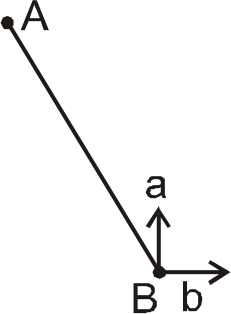A rod of length l is siding such that one of its ends is always in contact with a vertical wall and its other end is always in contact with horizontal surface. Just after the rod is relased from rest, the magnitude of acceleration of end points of the rod is and b respectively. The angular acceleration of road at this istant will be

a+bl
√|a2−b2|l
√a2+b2l
None of these
At the initial moment, angular velocity of rod is zero.
Acceleration of end B of rod with respect to end A is shown in figure.
Centripetal acceleration of point B with respect to A is zero (∵ω2l=0)
So at the initial moment, acceleration of end B with respect to end A is perpendicular to the rod which is equal to √a2+b2
arel=lα
√a2+b2l=α where α is angular acceleration

Topper's Solved these Questions
Similar Questions
A radioactive element decays by β−emission. A detector records n beta particles in 2s and in next 2s it records 0.75n beta particles. Find mean life correct to nearest whole number. Given ln |2|=0.6931, ln |3|=1.0986.
View SolutionWhen p−n junction diode is forward biased then
View SolutionA particle is attached to an end of a rigid rod. The other end of the rod is hunged and the rod rotates always remaining horizontal. Its angular speed is increasing at contant rate. The mass of the particle is m . The force exerted by the rod on the particle is →F , then:
View SolutionA uniform rod of mass m length l is attached to smooth hinge at end A and to a string at end B as shown in figure. It is at rest. The angular acceleration of the rod just after the string is cut is :

View SolutionA uniform rod of mass 20 Kg and length 1.6 m is piovted at its end and swings freely in the vertical plane. Angular acceleration of the rod just after the rod is relased from rest in the horizontal position is
View SolutionThe thin rod shown below has mases M and length L. A force F acts at one end as shown and the rod is free to rotate about the other end in horizontal plane. Initial angular acceleration of the rod is :
View SolutionA rod of mass M and length L is falling vertically with speed v . Suddenly its one end gets stuck in a friciitonless hook. Find the angular velocity of the rod just after its end gets struck.
View SolutionM द्रव्यमान तथा L लंबाई की एक छड़ को क्षैतिज तल में उसके एक सिरे पर ऊर्ध्व अक्ष के प्रति कीलकित किया गया है एक क्षैतिज बल F=Mg2 कीलकित सिरे से 5L6 दूरी पर छड़ पर आरोपित किया जाता है । छड़ का कोणीय त्वरण कितना होगा ?
View Solutionl लम्बाई की एक छड़ कब्जे पर अपने एक क्षैतिजतः सिरे पर घूमती है। यह गिरने के लिए स्वतन्त्र है। छड़ के दूसरे सिरे का वेग है
View SolutionA uniform rod of length 2m and mass 5kg is lying on a horizontal surface. The work done in raising one end of the rod with the other end in contact with the surface until the rod makes an angle 30^(@) with the horizontal is (g=10ms^(-2))
View SolutionA rod of length is sliding such that one of its ends is always in contact with a vertical wall and its other end is always in contact with horizontal surface. Just after the rod is released from rest, the magnitude of acceleration of end points of the rod a and b respectively. The angular acceleration of rod at this instant will be

View SolutionA uniform rod of mass 20 Kg and length 1.6 m is piovted at its end and swings freely in the vertical plane. Angular acceleration of the rod just after the rod is relased from rest in the horizontal position is

View Solutionएक m द्रव्यमान तथा l लम्बाई एक समान छड़ एक सिरे A पर चिकने कील ( घूम सकती है ) से तथा दूसरे सिरे B पर रस्सी से चित्रानुसार जुडी है। यह स्थिरावस्था में है। रस्सी को काटने के ठीक पश्चात छड़ का कोणीय त्वरण होगा

View SolutionA rod of mass M and length L is falling vertically with speed v . Suddenly its one end gets stuck in a friciitonless hook. Find the angular velocity of the rod just after its end gets struck.
View SolutionThe thin rod shown below has mases M and length L. A force F acts at one end as shown and the rod is free to rotate about the other end in horizontal plane. Initial angular acceleration of the rod is :

View Solution

